They’re Just Like Us: Celebrity Civilianizing on Social Media
Elizabeth Affuso / Pitzer College
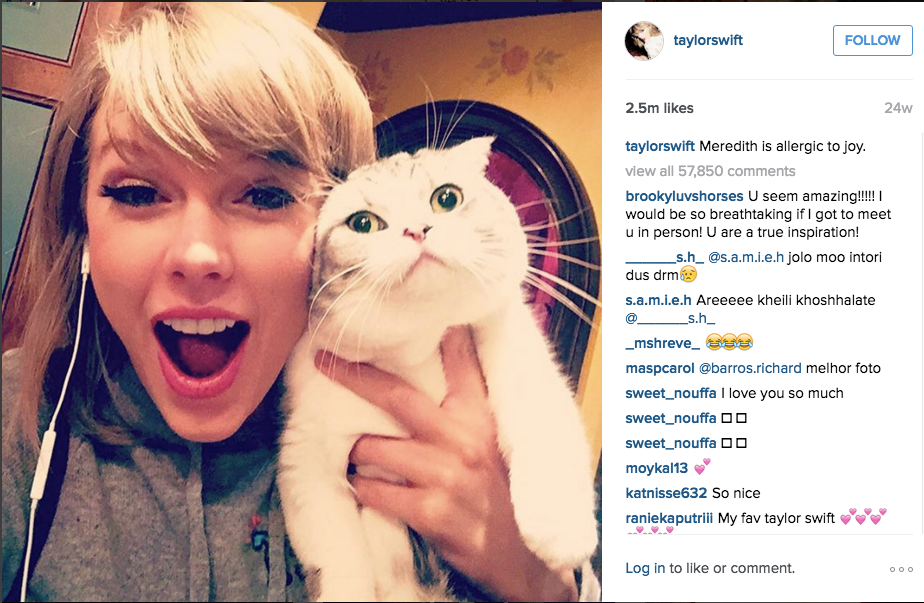
With the proliferation of new media, stars are expected to engage with their fans on a near 24/7 basis via social media spaces like Twitter, Tumblr, and Instagram. These spaces provide a perceived access never before seen in the fan/star relationship. Using social media, stars—or their anonymous assistants—showcase the day-to-day aspects of their lives. These spaces are used to post pictures of their pets, their breakfast, their friends, and their opinions about current events. All of this material is designed to make stars seem relatable to the public, while maintaining the rarified nature of celebrity. This desire for relatability is especially pervasive for young female celebrities who utilize their social media to position themselves within girl culture to emphasize the “stars are just like us” narrative of contemporary celebrity. This column will be invested in interrogating how female stars use iconographies of girlhood to emphasize how normal, and by extension relatable, they are on Instagram. For the sake of space, it will focus on Taylor Swift’s Instagram primarily in the era immediately after the release of her album 1989 (2014).
Many of the images circulating Instagram fall into the category that Yasmin Ibrahim has termed “banal imaging.”[1] The images are what might previously have been termed candids and represent new forms of digital recording of the banal or quotidian enabled by the pervasiveness of cameras and the quantities of memory on smartphones. These forms of “banal imaging” have been codified around images of healthy meals, vacations, bathroom mirror selfies, cute pets, fun nails, throwback Thursdays, and inspirational quotes as the aspirational goals of a certain specific form of girlfriendship in post-recession era digital culture. Stars utilize these same tropes in order to play into the language of girly-ness and make themselves seem relatable to their followers, while at the same time maintaining a rarefied star-like quality to their images. Of this symbiotic relationship, Alice Marwick has noted, “’regular’ selfies often emulate celebrity-related media.”[2] This idea can be extended to say that celebrity selfies often also emulate regular selfies. The visual and technological language of these images works from the same vein enabled by the shared functionalities of technology across smartphones.
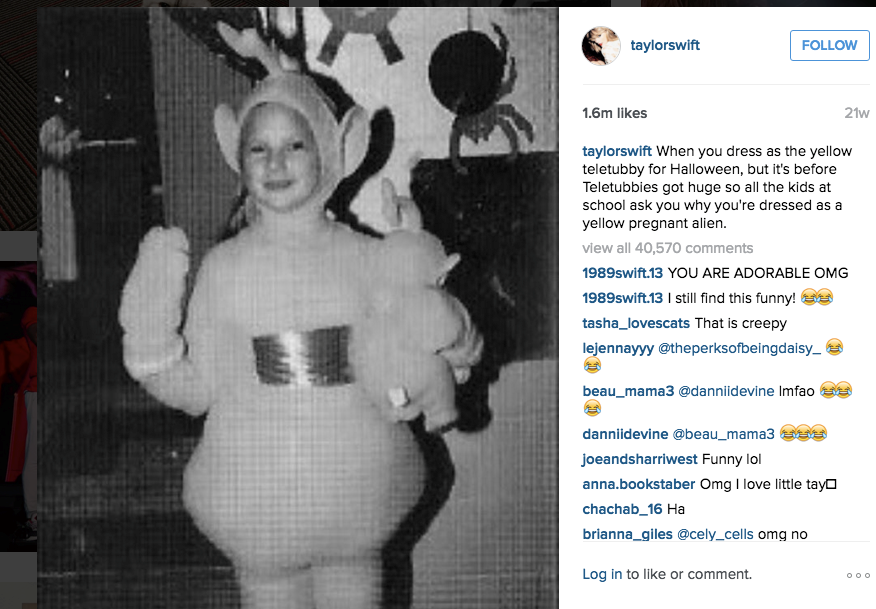
In recent years, Taylor Swift has been strongly associated with girl fandom and with the popularization of the idea of the girl squad—and its related hashtag #squadgoals. Of Swift, Megan Garber has written, “Swift is a performer not just of music, but of friendship. She takes the clichés of female camaraderie … and commercializes them.”[3] The move toward girl friendship relates to Swift’s own shift in branding away from the hapless, heartbroken romantic into a star who uses feminism and girl friendship as a tool of branding. This shift was centered on the launch of Swift’s well-received 1989 album with its anti-shaming anthem “Shake it off.” At the time, her social media was structured to mimic this shift in branding, positioning her best friendships with women such as Karlie Kloss and Selena Gomez front and center. This move towards girl friendship reflects a certain brand of celebrity feminism that is currently popular, with Beyoncé blaring feminism in lights and stars walking around in t-shirts proclaiming “The Future is Female.”
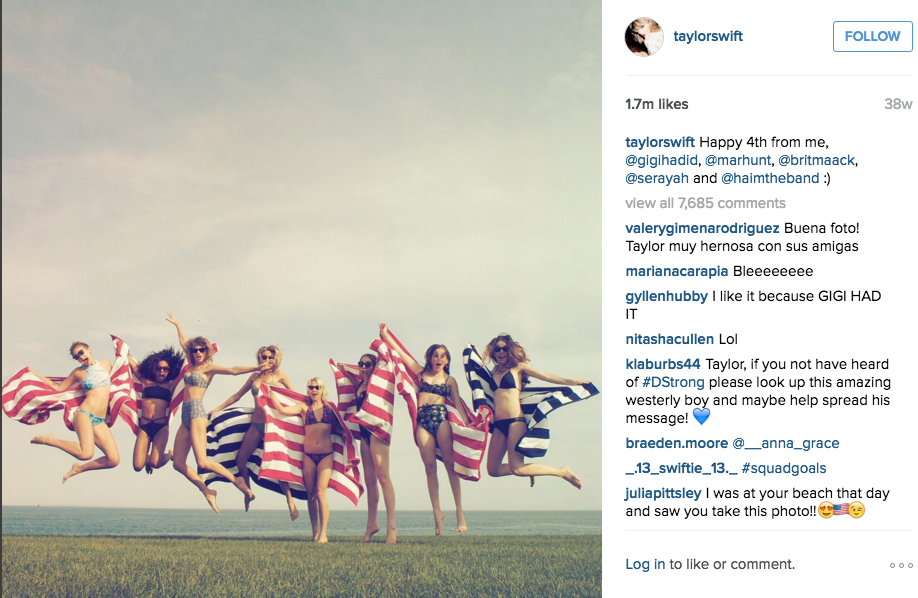
This performance of friendship is not just depicted in images of friendship—though there are plenty of those—but also in the types of images that she chooses to share with her followers. The mixture of celebrity images of Swift performing and doing other labor coded as professional with banal images allows for Swift’s photos to circulate seamlessly with those of “regular” users. In the temporality and structure of the Instagram feed, Swift’s images integrate seamlessly with those of real friends and give off the impression of Taylor Swift as regular girl, sharing videos of her cats—the ultimate embodiment of the “stars are just like us” discourse of celebrity circa 2018.
We know that cats drive the Internet and Swift’s cats are no exception, maintaining their position as stalwarts on her Instagram through her wipe and rebrand in advance of the release of 2017’s Reputation. Swift’s cats, Det. Olivia Benson and Dr. Meredith Grey, position Swift herself as a fan with the cat’s names as references to the female protagonists of Law and Order: SVU and Grey’s Anatomy respectively. Swift is deliberately branding herself as a fan or even a super fan, but what sets Swift apart is that her fandom does not require the same distance from the actual object as regular fans are subject to. When regular fans encounter celebrities like Swift, it’s primarily at events designed for fan engagement such as concerts or talk shows, but Swift now counts Mariska Hargitay, the actress who plays Det. Olivia Benson, as a member of her girl squad. Images of the feline Olivia Benson and Meredith Grey embody the limitations of the “stars are just like us” narrative in that “stars are just like us,” they have cats named after characters that they love, except that their cats fly private and use MTV awards as chew toys.
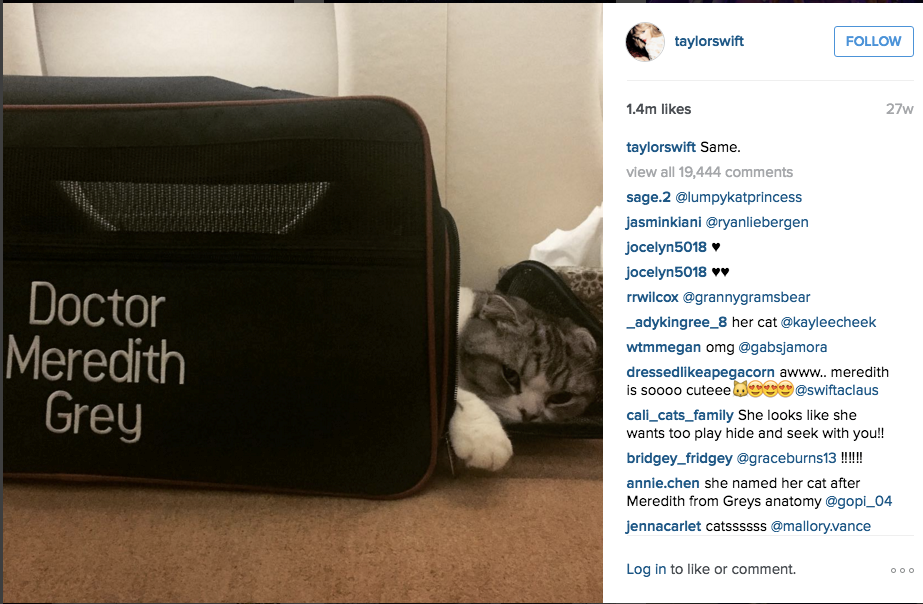
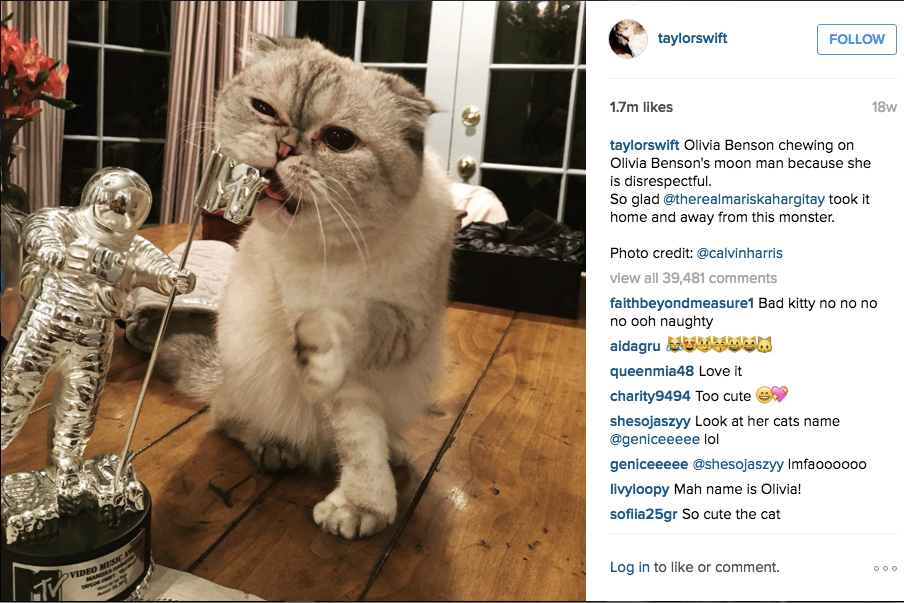
This alignment with fandom is something that Swift does again and again in her Instagram and it speaks to the cultural position of fandom in contemporary culture. No longer the province of nerds or geeks, fandom is mainstream enough that the queen bee of the ultimate girl clique, Swift’s squad, is happy to identify herself with it and to use it as a tool of relatability and the sanctioning of a certain kind of life. One that includes the markers of a luxurious version of girlhood complete with foodie 4th of July BBQs, Caribbean vacations, nail art, and boutique workouts. These forms of aspirational images pervade Instagram, driving the staging of images to meet these goals and encouraging the aestheticization of everyday life not just for celebrities, but for everyone.
This interest in banal imaging speaks to larger questions about labor and participation in digital culture. As with many banal images, these candids are not positioned as part of Swift’s work life, but rather as leisure images. This divide is complicated by Swift’s position as a celebrity where every part of public self is essentially work, including the images that are designed to explicitly not seem like work. Contemporary celebrity culture is full of images of celebrities seemingly living their real lives, from the paparazzi images of stars at Starbucks and the gym that fill up tabloids and gossip blogs, to the pet photos, domestic still lifes, and selfies shared on Instagram. Of these social media images, Alice Marwick has written that stars, “provide snapshots of their lives and interactions with followers that give the impression of candid, unfettered access.”[4] Thus, the appeal of these images is that they seem to be not part of public life, but rather a glimpse into the private lives of stars in their off work time, as if they are ever off work. And indeed, in the 24/7 affective network of contemporary culture, it raises questions about whether anyone is ever off work, celebrity or otherwise. As critic Rebecca Solnit has written, like TV shows, “life now had ratings.”[5] The tools of celebrity are no more rarefied, but rather ordinary tools of making and consumption.
Image Credits:
1. Taylor Swift’s Instagram account (author’s screengrab)
2. Taylor Swift’s Instagram account (author’s screengrab)
3. Taylor Swift’s Instagram account (author’s screengrab)
4. Taylor Swift’s Instagram account (author’s screengrab)
5. Taylor Swift’s Instagram account (author’s screengrab)
Please feel free to comment.
- Yasmin Ibrahim, “Instagramming life: banal imaging and the poetics of the everyday,” Journal of Media Practice 16:1 (2015): 42-54, 43. [↩]
- Alice Marwick. “Instafame: Luxury Selfies in the Attention Economy.” Public Culture 27:1 (2015): 137-160, 142. [↩]
- Megan Garber, “The Summer of the #Squad,” The Atlantic, July 23, 2015. http://www.theatlantic.com/entertainment/archive/2015/07/the-summer-of-the-squad/399308/ [↩]
- Marwick. “Instafame,” 139. [↩]
- Rebecca Solnit, “We’re Breaking Up: Noncommunications in the Silicon Age.” in The Encyclopedia of Trouble and Spaciousness, (Hartford, CT: Trinity University Press, 2014): 256-263, 257. [↩]
This is a very elastic article with a sense of humor. I have a common feeling described in the article in response to the “stars are just like us” narratives, especially when Taylor Swift is such a global super star and people around the world tend to pay attention on her luxurious version of quotidian life. Images of her cats and her girl squad often made top media coverage even on Asian social media platform. The part I enjoy reading the most is how young female celebrities use social media to present themselves in girl culture, because I fall into the demographics of young female fans and tend to participate in the fan engagement when having access to see celebrities’ outfit, cosmetics, and body training in their leisure time (or as the article question, maybe they are never off work), while at the same time cannot feel completely relatable to myself. The discussion on celebrity’s 24/7 affective network, reminds me of Michelle Cho’s presentation given at NYU Tisch School of the Arts about the “real life content” of K-pop boy band. Fans are willing to watch short videos of their idols eating, chatting, and relaxing during their music video shooting on YouTube channel. Different from images of Taylor Swift’s cat chewing on Mariska Hargitay’s “moon person”, these real life contents can possibly disregard the notion of economy and class. Cho also positions these videos as significance to build up personas and makes fans feel relatable to their idols’ lives.
How to appear as relatable as “girl next door” or “just like us” while retaining the mystic aura of celebrity is indeed an interesting challenge for celebrities of the digital age. This involves several interplaying layers of performance of intimacy. Mainly, the star has to be relatable enough for the general public to achieve potential expansion of her fanbase. That is, to let her material “circulate seamlessly with those of ‘regular’ users.” Meanwhile, she also has to draw a line between her fans and said general public and perhaps provides the former with even more material to form the sense of insider intimacy. That is, to form a somewhat exclusive “squad” where she performs the “queen bee” duties.
Moreover, it is also interesting to see that this practice has a clear gendered denotation. As stressed in the article, this practice goes along especially well with the logic of “girlhood,” “girlfriendship,” “girly” imaging, etc. This is partially due to the gender of the star, but more fundamentally due to the heavily gendered fandom. It is then worth considering how a star could form intimacy/relatability with a fundamentally male fanbase, or with the marginalized male fans within a female-dominated fandom.
Although I do not follow Taylor Swift on any social media platform, I agree with Affuso’s argument. Swift’s whole persona seems to be manicured as the relatable girl next door as she skillfully uses her Instagram account, for example, as a way to keep her image that way. However, I also believe her social media presence is constantly used for damage control as well. Swift has come under fire many times for different reasons: She’s been accused of propagating unrealistic body types (since her “squad” only consists of models,) being conniving and a liar (the whole feud between her, Kanye West, and Kim Kardashian got worse when she lied about Kanye not telling her about a song he wrote – Kardashian’s fans started flooding Swift’s instagram account with snake emojis after that,) suing people for copyright infringement even though she recently released a video where she seems to have copied the concept and dance moves from a Kenzo commercial, most famously dating various famous men and writing songs about them after they break up, and even being accused of being a “fake feminist.”
On her Instagram, she does not seem to address any of these issues. I recently checked her account since I’m writing about it on here, and it seems that she is currently only posting about her music (aside from a couple of cat photos/videos,) which makes me feel she could be trying to figure out a new image for herself or just trying to stay clear of any controversy. I guess only time will tell for sure, but I still believe firmly Swift and other celebrities use social media not only to look relatable to their fans but also to control their image and do damage control.
I personally like this post perhaps it represents and speaks to how social media is shaping people’s ways of thinking. On the one hand, media provide massive opportunities to establish individualism according to one’s will. On the other hand, and also where I think the humor comes from, is that to some degree the behaviors on social media more or less speaks something because every angle, every image, every word are choices from consciousness, but satire might be established upon the process by how much we believe the degree of manipulation of postings. But I still, and wish to believe that everyone has the rights to enjoy expressing themselves using cyberspace, and everyone else maintains their own criteria of judgments. And I believe that’s why we could devoid “sameness” of liberty and freedom. I remember at the beginning of the TV graduate course at Tisch, we were watching “Nosedive” from Black Mirror, which I thought would be a wonderful version contemplating social media from the perspective on both dystopian fiction and social satire. We’ve also discussed ordinary celebrity and fandom, and at the very end, I would like to conclude using inspiring words from our reading list “We used newly available sets of technologies to self-document and share our lives, ideas and and movements, to make our own educational and culture materials, to speak to and against the ‘mainstream’ media and culture, and to work to alter material reality through carefully enacted and theorized acts of representation” (McCarthy: Ambient Television: Visual Culture and Public Space) to denote that “stars are just like us” as narrative approach to read stardom phenomena.
What interested me a lot from this post is its idea of “Stars just like us” and its gendered label “girl culture”.
Firstly, I think currently, “Stars just like us” is a very popular trend. All of these materials are designed to make stars seem relatable to the public. Fans and ordinary people begin to know that they are not only the stars, they are also the regular people like us. I would say that posting the private life, recording of the banal or quotidian life of stars is a kind of promotion strategy, it can help stars to erase the barrier between themselves and ordinary people. It is also a strategy to win more fans. I still remember Michelle Cho’s presentation on Kpop. She used Vlive as an example. Vlive is a social media platform where celebrity can video themselves. Fans thus have the opportunity to get more close to their idols. In addition, she also described the key that why Kpop is so popular. This is because its “co-feeling”: Kpop can be seen as the combination of music, video, content and social media. It is really easy for fans to reach their idols. Idols are talking about the young people in the word, which can resonate fans’ own feeling. I think the term “co-feeling” is akin to what this article has mainly discussed the idea that the “Stars just like us”
Secondly, I think it is very interesting that this article uses Taylor Swift as an example and defines what she is doing is the representation of “girl culture”. I agree that her move towards girl friendship reflects a certain brand of celebrity feminism that is currently popular. And I remember that I have seen a report saying that most of the fans are female. Perhaps this is the reason why girls are easy to attract by this kind of “branding strategy”. However, I think the author ignores the male celebrities and male fans. I would like to give an example from China. Currently, nearly all the stars in China use Weibo (Chinese facebook/twitter) to share their life or agenda. Some male stars use Weibo to give fans a totally subversive image of themselves. They also post some very humorous content and play jokes on their friends who are also the famous stars. These moves really help them win many fans and we also consider that stars are not the people who are standing on the top of the hill, they are also just the regular people like us.
goonga ginga